See the Nile Cruise pictures and feel the spirit of ancient Egypt
(Click the image in order to see more photos of that place)
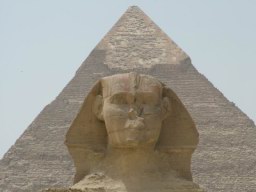 |
The Pyramids of Giza
Giza (some 20 km from central Cairo) western district of Cairo word-famous for it's Pyramids and The Great Sphinx which are one of the most impressive ancient monuments in the world. The Great Pyramid of Giza is one of largest in Egypt and in the world. It is one of the Seven Wonders of the World, and the only one of the seven to survive into modern times. |
Cairo
The capital city of Egypt, with population of approximately 15.2 million people, the largest in Africa. Cairo is the sixteenth most populous metropolitan area in the world. Located on the banks and islands of the Nile River in the north of Egypt. Cairo is becoming center for tourism as people from around the world are comming to see the monuments and artifacts of Ancient Egypt, especially the Pyramids and Egyptian Museum which is the only place in the world where that many items can be seen. |
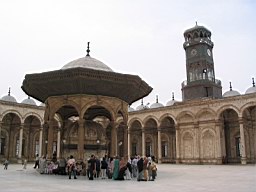 |
 |
Memphis
The ancient capital of Lower Egypt, called in the past Ineb Hedj (The White Walls). The ruins of the city are 19 km south of Cairo on the West Bank of the Nile. The city was founded around 3100 BC by Menes of Tanis, who united the two kingdoms of Egypt. Memphis reached a peak of prestige under the 6th Dynasty as a centre of the cult of Ptah. The remains of the temple of Ptah and of Apis have been uncovered at the site as well as a few statues, including two four metre ones in alabaster of Ramesses II.
|
Luxor Temple
The city of Luxor known as ancient Thebes was the capital of Egypt during part of the Eleventh Dynasty (Middle Kingdom), and most of the Eighteenth Dynasty (New Kingdom). The archaeological remains of Thebes offer a striking testimony to Egyptian civilization at its height. The city is called "world's greatest open air museum", for it's ruins of the temple complexes at Karnak and Luxor. On the other site of Nile River, lie the monuments, temples and tombs on the West Bank Necropolis, which include the Valley of the Kings and Queens. |
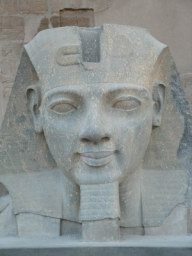 |
 |
Colossi of Memnon
They are two massive stone statues of Pharaoh Amenhotep III. The statues are made from blocks of quartzite sandstone, they reach 18 metres in height.The original function of the Colossi was to stand guard at the entrance to Amenhotep's memorial temple: a massive cult centre built during the pharaoh's lifetime, where he was worshipped as a god-on-earth both before and after his departure from this world. Memnon was a hero of the Trojan War, a King of Ethiopia who led his armies from Africa into Asia Minor to help defend the beleaguered city but was ultimately slain by Achilles. Associating the Colossi with his name generally referred to the entire Theban Necropolis as the "Memnonium". |
Medinet Habu (Coloured Temple)
The Mortuary Temple of Ramses III. Medinet Habu is about 4 miles from the Valley of the Kings near the foot of the Theban Hills at the southern end of western Thebes. The mortuary temple is the best preserved temple at Thebes. Ramses III had an usual entrance built for the complex, modeled perhaps on citadels he had seen on military campaigns in Syria. The tower is in the form of a "migdol," a kind of fortified gate house. The complex have the look of a fortress since originally it was enclosed by a mud brick wall 35 feet thick and 60 feet high. The complex of buildings here dates from the early 18th Dynasty, when Hatshepsut and Tuthmose III dedicated a temple to Amun, to Roman times. |
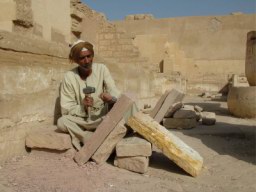 |
 |
Valley of the Kings
It stands on the west bank of the Nile, across from Thebes, under the peak of the pyramid-shaped mountain Al-Qurn. The tombs in this valley were built for the Pharaohs and powerful nobles of the New Kingdom, the Eighteenth through Twentieth Dynasties of Ancient Egypt. It is separated into the East and West Valleys, with most of the important tombs in the East Valley. The West Valley has only one tomb open to the public: the tomb of Ay, Tutankhamun's successor. There are a number of other important burials there, including that of Amenhotep III, but these are still being excavated and are not publicly accessible.
The Valley was used for primary burials from approximately 1539 BC to 1075 BC, and contains some 64 tombs, starting with Thutmose I and ending with Ramesses X or XI.
|
Karnak Temple
El-Karnak is a small village located on the banks of the River Nile some 2.5 km north of Luxor. It is a vast open-air museum and the largest ancient religious site in the world, and is probably the second most visited ancient site in Egypt.
It consists of four main parts, of which only one is accessible for tourists, this part is Precinct of Amon-Re, which is the largest of the precincts of the temple complex, and is dedicated to Amun-Re, the chief god of the Theban Triad. This is also the "main" temple part and by far the largest part. The three other parts are closed to the public.
Construction work began in the 16th century BC. Approximately 30 pharaohs contributed to the buildings, enabling it to reach a size, complexity and diversity not seen elsewhere. |
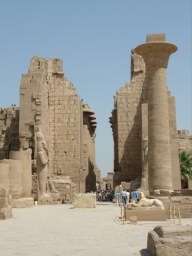 |
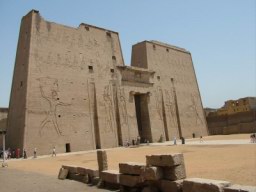 |
Edfu - The Temple of Horus
Edfu is located on the west bank of the River Nile between Esna and Aswan. The Temple of Edfu was built from sandstone blocks being constructed over the site of a smaller New Kingdom temple, oriented east to west, facing towards the river. The later structure faces north to south and leaves the ruined remains of the older temple Pylon to be seen on the east side of the first court. After Karnak, it is the second largest temple in Egypt; it is also one of the best preserved. Construction began under Ptolemy III Euergetes in the 3rd century BCE. |
The Nubian Village
Nubia is the region in the south of Egypt, along the Nile and in northern Sudan, but in ancient times it was an independent kingdom. The earliest cultures of Nubia left no writings and are unreported in the annals of other nations. The first noticeable cultures in Nubia include first the Badarian culture, then the Amratian and finally the Gerzean.
Recently many Egyptian Nubians were forcibly resettled to make room for Lake Nasser after the construction of the dams at Aswan. Nubian villages can now be found north of Aswan on the west bank of the Nile and on Elephantine Island. It's worth to visit one of them to see it's specific culture and art. |
 |
 |
Aswan
City in the south of Egypt, identified with the ancient city of Syen. It stands on the east bank of the Nile at the first cataract and is a busy market and tourist center.
Aswan is one of the driest inhabited places in the world, the last rain here was 6 years ago. |
Philae Island - Temple of Isis
The island temple at Philae was constructed over a three-century period, by the Greek Ptolemaic dynasty and the Roman Pricipate. The principal deity of the temple complex was Isis, but other temples and shrines were dedicated to her son Horus and the goddess Hathor.
The complex is now located on the nearby island of Agilika 550 meters away. |
 |
 |
Kom Ombo Temple
The Temple of Kom Ombo is an unusual double temple built during the Ptolemaic Period in the Egyptian town of Kom Ombo. One side of the temple is dedicated to the crocodile god Sobek, god of fertility and creator of the world. The other side is dedicated to the falcon god Haroeris, also known as Horus the Elder. Much of the temple has been destroyed by the Nile, earthquakes, and later builders who used the stones for other projects. Some of the reliefs inside were defaced by Copts who once used the temple as a church. A few of the three-hundred crocodile mummies discovered in the vicinity are displayed inside the temple. |
Abu Simbel with two monumental Temples of Ramzes II
and his wife Nefertari
Abu Simbel is an archaeological site comprising two massive rock temples in southern Egypt on the western bank of Lake Nasser about 290 km southwest of Aswan. It is part of the UNESCO World Heritage Site. The twin temples were carved out of the mountainside during the reign of Pharaoh Ramesses II in the 13th century BC, as a lasting monument to himself and his queen Nefertari, to commemorate his alleged victory at the Battle of Kadesh, and to intimidate his Nubian neighbors. The complex was relocated in its entirety in the 1960s to avoid being submerged during the creation of Lake Nasser. Construction of the temple complex started in approximately 1284 BC and lasted about 20 years, until 1264 BC. Known as the "Temple of Ramesses, beloved by Amun", it was one of six rock temples erected in Nubia during the long reign of Ramesses. Their purpose was to impress Egypt's southern neighbours, and also to reinforce the status of Egyptian religion in the region. |
 |

|
